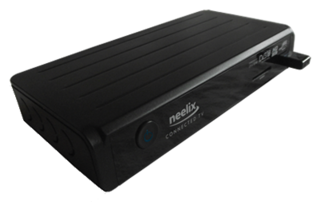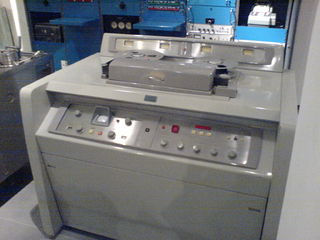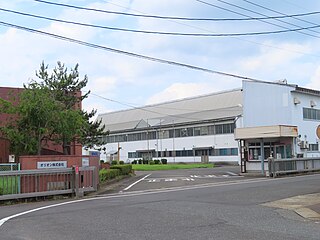
A set-top box (STB), also known as a cable box or receiver and historically television decoder or a converter, is an information appliance device that generally contains a TV-tuner input and displays output to a television set and an external source of signal, turning the source signal into content in a form that can then be displayed on the television screen or other display device. They are used in cable television, satellite television, and over-the-air television systems as well as other uses.

The VHS is a standard for consumer-level analog video recording on tape cassettes, invented in 1976 by the Victor Company of Japan (JVC). It was the dominant home video format throughout the tape media period in the 1980s and 1990s.

Videotape is magnetic tape used for storing video and usually sound in addition. Information stored can be in the form of either an analog or digital signal. Videotape is used in both video tape recorders (VTRs) and, more commonly, videocassette recorders (VCRs) and camcorders. Videotapes have also been used for storing scientific or medical data, such as the data produced by an electrocardiogram.

JVC is a Japanese brand owned by JVCKenwood. Founded in 1927 as the Victor Talking Machine Company of Japan and later as Victor Company of Japan, Ltd., the company was best known for introducing Japan's first televisions and for developing the Video Home System (VHS) video recorder.

S-VHS (スーパー・ヴィエイチエス), the common initialism for Super VHS, is an improved version of the VHS standard for consumer-level video recording. Victor Company of Japan introduced S-VHS in Japan in April 1987, with their JVC-branded HR-S7000 VCR, and in certain overseas markets soon afterward. By the end of 1987, the first S-VHS VCR models from other competitors included Hitachi VT-2700A, Mitsubishi HS-423UR, Panasonic PV-S4764, RCA VPT-695HF, and Toshiba SV-950. It has been standardized as IEC 60774-3 and IEC 60774-4.

A camcorder is a self-contained portable electronic device with video and recording as its primary function. It is typically equipped with an articulating screen mounted on the left side, a belt to facilitate holding on the right side, hot-swappable battery facing towards the user, hot-swappable recording media, and an internally contained quiet optical zoom lens.
A digital video recorder (DVR) is an electronic device that records video in a digital format to a disk drive, USB flash drive, SD memory card, SSD or other local or networked mass storage device. The term includes set-top boxes (STB) with direct to disk recording, portable media players and TV gateways with recording capability, and digital camcorders. Personal computers are often connected to video capture devices and used as DVRs; in such cases the application software used to record video is an integral part of the DVR. Many DVRs are classified as consumer electronic devices; such devices may alternatively be referred to as personal video recorders (PVRs), particularly in Canada. Similar small devices with built-in displays and SSD support may be used for professional film or video production, as these recorders often do not have the limitations that built-in recorders in cameras have, offering wider codec support, the removal of recording time limitations and higher bitrates.

A video tape recorder (VTR) is a tape recorder designed to record and playback video and audio material from magnetic tape. The early VTRs were open-reel devices that record on individual reels of 2-inch-wide (5.08 cm) tape. They were used in television studios, serving as a replacement for motion picture film stock and making recording for television applications cheaper and quicker. Beginning in 1963, videotape machines made instant replay during televised sporting events possible. Improved formats, in which the tape was contained inside a videocassette, were introduced around 1969; the machines which play them are called videocassette recorders.

The videotape format war was a period of competition or "format war" of incompatible models of consumer-level analog video videocassette and video cassette recorders (VCR) in the late 1970s and the 1980s, mainly involving the Betamax and Video Home System (VHS) formats. VHS ultimately emerged as the preeminent format.

A home theater PC (HTPC) or media center computer is a convergent device that combines some or all the capabilities of a personal computer with a software application that focuses on video, photo, audio playback, and sometimes video recording functionality. Since the mid-2000s, other types of consumer electronics, including game consoles and dedicated media devices, have crossed over to manage video and music content. The term "media center" also refers to specialized application software designed to run on standard personal computers.
A DVD recorder is an optical disc recorder that uses optical disc recording technologies to digitally record analog or digital signals onto blank writable DVD media. Such devices are available as either installable drives for computers or as standalone components for use in television studios or home theater systems.

U-matic or 3⁄4-inch Type E Helical Scan or SMPTE E is an analogue recording videocassette format first shown by Sony in prototype in October 1969, and introduced to the market in September 1971. It was among the first video formats to contain the videotape inside a cassette, as opposed to the various reel-to-reel or open-reel formats of the time. The videotape is 3⁄4 in (19 mm) wide, so the format is often known as "three-quarter-inch" or simply "three-quarter", compared to open reel videotape formats in use, such as 1 in (25 mm) type C videotape and 2 in (51 mm) quadruplex videotape.

D-VHS is a digital video recording format developed by JVC, in collaboration with Hitachi, Matsushita, and Philips. The "D" in D-VHS originally stood for "Data", but JVC renamed the format as "Digital VHS". Released in December 1997, it uses the same physical cassette format and recording mechanism as S-VHS, but requires higher-quality and more expensive tapes and is capable of recording and displaying both standard-definition and high-definition content. The content data format is in MPEG transport stream, the same data format used for most digital television applications. It used MPEG-2 encoding and was standarized as IEC 60774-5.
A VCR/DVD combination, VCR/DVD combo, or DVD/VCR combo, is a multiplex or converged device that allows the ability to watch both VHS tapes and DVDs. Many such players can also play additional formats such as CD and VCD.

A home theater in a box (HTIB) is an integrated home theater package which "bundles" together a combination DVD or Blu-ray player, a multi-channel amplifier, speaker wires, connection cables, a remote control, a set of five or more surround sound speakers and a low-frequency subwoofer cabinet. Manufacturers also have come out with the "soundbar", an all in one device to put underneath the television and that contains all the speakers in one unit.

Bravia (stylized as BRAVIA) is a brand of Sony Visual Products Inc., a wholly owned subsidiary of Sony, and is used for its television products. Its name is a backronym for "Best Resolution Audio Visual Integrated Architecture". All Sony high-definition flat-panel LCD televisions in North America have carried the logo for BRAVIA since 2005. BRAVIA replaces the "LCD WEGA," which Sony used for their LCD TVs until summer 2005 (early promotional photos of the first BRAVIA TVs still bearing the WEGA moniker). In 2014 (on the part of Sony President and CEO Kazuo Hirai's plans to turn Sony around), BRAVIA was made into a subsidiary rather than simply a brand of products.

Orion Co., Ltd. was a Japanese consumer electronics company that was established in 1958 in Osaka, Japan. Their devices were branded as "Orion".

A videocassette recorder (VCR) or video recorder is an electromechanical device that records analog audio and analog video from broadcast television or other AV sources and can play back the recording after rewinding. The use of a VCR to record a television program to play back at a more convenient time is commonly referred to as time shifting. VCRs can also play back prerecorded tapes, which were widely available for purchase and rental starting in the 80s and 90s, most popularly in the VHS videocassette format. Blank tapes were sold to make recordings.

The JVC HR-3300 VIDSTAR is the world's first VHS-based VCR to be released to the market, introduced by the president of JVC at the Okura Hotel on September 9, 1976. Sales started in Japan under the name Victor HR-3300 on 31 October 1976. Foreign sales followed in 1977 with the HR-3300U in the United States, and HR-3300EK in the United Kingdom.

















